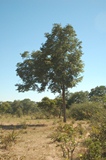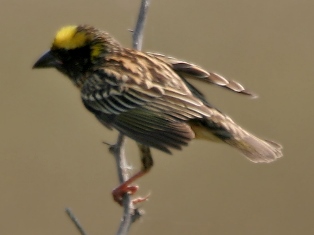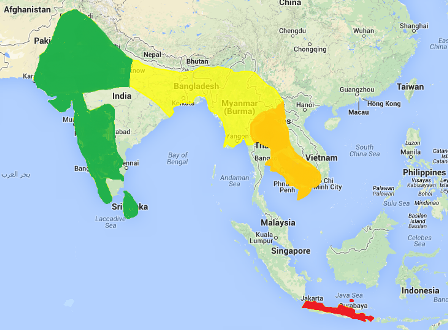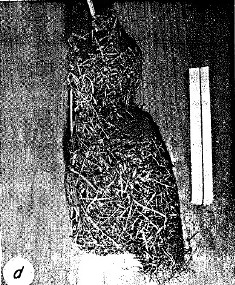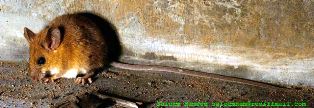Weaver species
Choose different species from drop-down list and press 'Go' button. See Full species list.Streaked Weaver Ploceus manyar
IUCN: Least concern Discovery: 030Categories: Asian, long tube, white eggs, Nest use, palm,
News items about species
Discovery
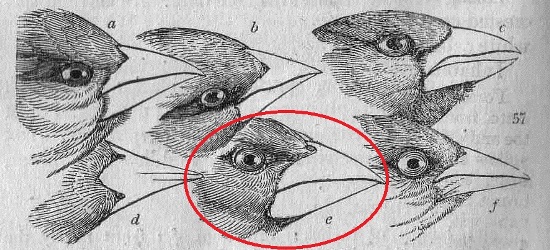
figure from Swainson 1838 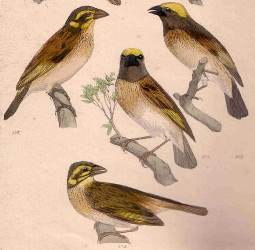
figure from Reichenbach 1863 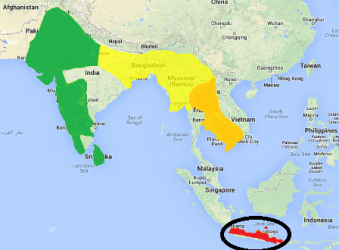
distribution, type locality circled IntroductionThe Streaked Weaver was formally described by Thomas Horsfield, an American physician and naturalist. Horsfield lived and worked on Java Island in Indonesia from 1811-17. Horsfield began to collect plants and animals on behalf of the governor and friend Sir Thomas Stamford Raffles. In 1816 Java was restored to the Dutch and Horsfield moved east to Sumatra.In 1819 Horsfield left Sumatra due to ill health and returned to London. On returning to London, Horsfield continued to be in contact with Sir Stamford Raffles and became a keeper of the museum of the East India Company. He stayed in this position, later as a curator, until his death in 1859. Ultimately the Museum was overwhelmed with collections, and much of the material had to be distributed to other museums, scientific societies. One specimen of the Streaked Weaver is still in the British museum at Tring, but there are probably 3 more type specimens. The first illustration of a Streaked Weaver is a line drawing of the head and bill in Swainson 1838. The next illustration is a set of birds painted in colour by Reichenbach (1863). Scientific citationFringilla manyar Horsfield 1821 Trans. Linn. Soc. London, 13, p.160 Java.Meaning of namesmanyar Tamil (Sri Lankan) name manja for various weaverbirds.First English nameBrahminee Baya (Jerdon 1845). In 1840, Jerdon had applied this name to the Bengal Weaver, but then realised that it should apply to this species.Alternate namesBrahminee Baya, Burmese Streaked Weaver Bird, Indian Streaked Weaver Bird, Javan Weaver, Manyar Weaver, Striated Weaver.CollectorHorsfield.Date collectedBetween 1811-17 when Horsfield was collecting on Java.Locality collectedJava.Type specimensAt least one syntype is in the British Museum (BM 1880.1.1.4730). |
The above is based on Weaver Wednesday 2, a weekly series about the discovery of each weaver species.
This species text first appeared as
Weaver Wednesday [147] - Discovery [30]: Streaked Weaver on 2015-04-08
1. Basic biology
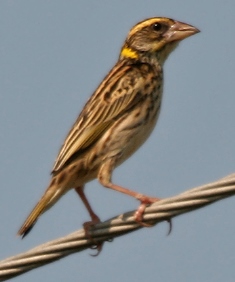
non-breeding, figure from wikipedia Identification.
The Streaked Weaver Ploceus manyar breeding male has a golden crown, black face and throat, and the underparts are white with black breast streaks. The non-breeding male and female are dull with a buff eyebrow, and lightly streaked breast, distinguishing them from the other Asian weavers. The juvenile is buffy below with indistinct streaking.
Distribution.
Four races are recognised (see map below, based on Handbook of the Birds of the World, Vol. 15):
The Streaked Weaver has been introduced in Egypt along the Nile Delta, where it breeds regularly. It has also been introduced in Japan. Breeding has also been recorded in Saudi Arabia, United Arab Emirates and Bahrain, presumably by captive birds that escaped. Habitat. The Streaked Weaver inhabits wetlands, reedbeds and rice paddies, often with bulrushes, and it often associates with elephant grass. Food. The Streaked Weaver feeds mainly on seeds, including those of the grasses, rice, wheat, millet and sorghum. In some regions it causes significant damage to rice crops. Nestlings are fed mainly with insects, especially grasshoppers, and also caterpillars, beetles, spiders, and small snails. The Streaked Weaver forages in flocks, often with other weavers. It forms daytime roosts near its feeding grounds during the hottest months. In the non-breeding season, it forms communal roosts in reedbeds and sugar cane. Breeding.
The Streaked Weaver is apparently monogamous, with occasional polygyny recorded. It is colonial, with 15-50 nests at one site in Java. It may breed in mixed colonies with the Black-breasted Weaver (or Bengal Weaver), or alongside Tricoloured Mannikin Lonchura malacca nests.
The nest is retort-shaped, woven on to leaves of supporting plants. There may be an entrance tunnel as long as 30 cm or it may be absent. The nest is woven by the male from strips of reed or palm leaves. The female adds nest lining of fine grass stems, although some breeding nests are unlined. The nest is placed above the water surface in reeds and bulrushes, or in elephant grass. Nest sites also include palm trees (especially in Java), or mangrove trees, or suspended from vegetation growing out of sides of irrigation wells. Often small lumps of mud or clay are added to the sides of the nest entrance. Yellow acacia flowers may be added to the nest as decoration. Nests may be placed near wasps as protection. 2-3 white eggs are laid. The female does most of the incubation and feeding of the nestlings. Nest predators include snakes and crows. In reedbeds, many nests are destroyed by grazing cattle and by people harvesting reeds.
Small birds, eg Indian Silverbill, and the long-tailed tree mouse has been recorded to take over old nests of the Streaked Weaver. |
The above is based on Weaver Wednesday, a weekly series about weaver species.
This species text first appeared as
Weaver Wednesday [101]: Streaked Weaver on 2014-05-21
2. Breeding facts
| Pair bond Apparently monogamous, with occasional polygyny Breeding season Jun-Sept in Pakistan and India (in S India, nesting dependent on rainfall and suitable growth of bulrushes), Feb-Apr and Jul-Oct in Sri Lanka, Jun-Oct in Myanmar and Mar-May in Java; introduced population breeds in May in Egypt, and nest-building recorded Apr-May (but no eggs laid) in Saudi Arabia Nest site nest placed up to 2 m above water surface in reeds and bulrushes, or in elephant grass, sometimes in palm (favoured site in Java), or on mangrove close to human habitation, and in some areas suspended from vegetation growing out of sides of irrigation wells Nest building woven by male Colony size Coloniai, 15-50 nests at site in Java Clutch size 2-3 eggs Egg colour white Egg size average size of 50 eggs 20.3 x 14.3 mm Incubation incubation shared by male initially, then done by female alone, period 14-17 days Chicks and nestling period chicks fed by both sexes, male contributing once nestlings c. 10 days old, nestling period c. 17-18 days |
Breeding information based on Handbook of the Birds of the World, Vol. 15.
3. Photos of Weaver Nests
No records yet - be the first to submit a PHOWN record!See PHOWN summary page for this species here.
PHOWN (Photos of Weaver Nests) provides valuable info on breeding distribution and colony sizes of weavers.
You can contribute by registering and submitting photos at Virtual Museum webpage.
4. Breeding distribution
Google map showing distribution (For species with small ranges you need to zoom in at the correct area to see the range):
yellow blob - range of weaver species; read more about this here.
![]() - PHOWN records with photos
- PHOWN records with photos
![]() - PHOWN records with no photos (Nest Record Cards, other records)
- PHOWN records with no photos (Nest Record Cards, other records)
![]() - Birdpix records
- Birdpix records
![]() - comments on out of range records, or interesting records
- comments on out of range records, or interesting records
![]() - type locality
- type locality
CLICK on the marker on the map to see individual record details.
5. Range changes
Not South African speciesThe above is based on Weaver Wednesday 3, a weekly series about range changes in South African weaver species.
This species text first appeared as
n/a








